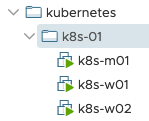Configure Kubernetes In-Tree vSphere Cloud Provider
In this post I will show you how can you use vmware for persistent storagi on K8S.
Parts of the Kubernetes series
- Part1a: Install K8S with ansible
- Part1b: Install K8S with kubeadm
- Part1c: Install K8S with kubeadm and containerd
- Part1d: Install K8S with kubeadm and allow swap
- Part1e: Install K8S with kubeadm in HA mode
- Part2: Intall metal-lb with K8S
- Part2: Intall metal-lb with BGP
- Part3: Install Nginx ingress to K8S
- Part4: Install cert-manager to K8S
- Part5a: Use local persisten volume with K8S
- Part5b: Use ceph persisten volume with K8S
- Part5c: Use ceph CSI persisten volume with K8S
- Part5d: Kubernetes CephFS volume with CSI driver
- Part5e: Use Project Longhorn as persisten volume with K8S
- Part5f: Use OpenEBS as persisten volume with K8S
- Part5f: vSphere persistent storage for K8S
- Part6: Kubernetes volume expansion with Ceph RBD CSI driver
- Part7a: Install k8s with IPVS mode
- Part7b: Install k8s with IPVS mode
- Part8: Use Helm with K8S
- Part9: Tillerless helm2 install
- Part10: Kubernetes Dashboard SSO
- Part11: Kuberos for K8S
- Part12: Gangway for K8S
- Part13a: Velero Backup for K8S
- Part13b: How to Backup Kubernetes to git?
- Part14a: K8S Logging And Monitoring
- Part14b: Install Grafana Loki with Helm3
vSphere Configuration
- Create a folder for all the VMs in vCenter
- In the navigator, select the data center
- Right-click and select the menu option to create the folder.
- Select: All vCenter Actions > New VM and Template Folder.
- Move K8S vms to this folder
- The name of the virtual machine must match the name of the nodes for the K8S cluster.

Set up the GOVC environment:
# on deployer
curl -LO https://github.com/vmware/govmomi/releases/download/v0.20.0/govc_linux_amd64.gz
gunzip govc_linux_amd64.gz
chmod +x govc_linux_amd64
cp govc_linux_amd64 /usr/bin/govc
echo "export GOVC_URL='vCenter IP OR FQDN'" >> /etc/profile
echo "export GOVC_USERNAME='vCenter User'" >> /etc/profile
echo "export GOVC_PASSWORD='vCenter Password'" >> /etc/profile
echo "export GOVC_INSECURE=1" >> /etc/profile
source /etc/profile
Add disk.enableUUID=1 for all VM:
govc vm.info <vm>
govc ls /Datacenter/kubernetes/<vm-folder-name>
# example:
govc ls /Datacenter/kubernetes/k8s-01
govc vm.change -e="disk.enableUUID=1" -vm='VM Path'
# example:
govc vm.change -e="disk.enableUUID=1" -vm='/datacenter/kubernetes/k8s-01/k8s-m01'
VM Hardware should be at version 15 or higher. Upgrade if needed:
govc vm.option.info '/datacenter/kubernetes/k8s-01/k8s-m01' | grep HwVersion
govc vm.upgrade -version=15 -vm '/datacenter/kubernetes/k8s-01/k8s-m01'
Create the required Roles
- Navigate in the vSphere Client - Menu > Administration > Roles
- Add a new Role and select the permissions required. Repeat for each role.
| Roles | Privileges | Entities | Propagate to Children |
|---|---|---|---|
| vcp-manage-k8s-node-vms | Resource.AssignVMToPoolVirtualMachine.Config.AddExistingDisk, VirtualMachine.Config.AddNewDisk, VirtualMachine.Config.AddRemoveDevice, VirtualMachine.Config.RemoveDisk, VirtualMachine.Config.SettingsVirtualMachine.Inventory.Create, VirtualMachine.Inventory.Delete | Cluster, Hosts, VM Folder | Yes |
| vcp-manage-k8s-volumes | Datastore.AllocateSpace, Datastore.FileManagement (Low level file operations) | Datastore | No |
| vcp-view-k8s-spbm-profile | StorageProfile.View (Profile-driven storage view) | vCenter | No |
| Read-only (pre-existing default role) | System.Anonymous, System.Read, System.View | Datacenter, Datastore Cluster, Datastore Storage Folder | No |
Create a service account
- Create a vsphere user, or add a domain user, to provide access and assign the new roles to.
Create vsphere.conf
Create the vSphere configuration file in /etc/kubernetes/vcp/vsphere.conf - you’ll need to create the folder.
nano /etc/kubernetes/vcp/vsphere.conf
[Global]
user = "k8s-user@vsphere.local"
password = "password for k8s-user"
port = "443"
insecure-flag = "1"
[VirtualCenter "10.0.1.200"]
datacenters = "DC-1"
[Workspace]
server = "10.0.1.200"
datacenter = "DC-1"
default-datastore = "vsanDatastore"
resourcepool-path = "ClusterNameHere/Resources"
folder = "kubernetes"
[Disk]
scsicontrollertype = pvscsi
Modify the kubelet service
On master:
nano /etc/systemd/system/kubelet.service
[Service]
...
ExecStart=/usr/bin/docker run \
...
/hyperkube kubelet \
...
--cloud-provider=vsphere --cloud-config=/etc/kubernetes/vsphere.conf
On worker:
nano /etc/systemd/system/kubelet.service
[Service]
...
ExecStart=/usr/bin/docker run \
...
/hyperkube kubelet \
...
--cloud-provider=vsphere
Modify container manifests
Add following flags to the kubelet service configuration (usually in the systemd config file), as well as the controller-manager and api-server container manifest files on the master node (usually in /etc/kubernetes/manifests).
nano /etc/kubernetes/manifests/kube-apiserver.yaml
...
spec:
containers:
- command:
- kube-apiserver
...
- --cloud-provider=vsphere
- --cloud-config=/etc/kubernetes/vsphere.conf
volumeMounts:
- mountPath: /etc/kubernetes/vcp
name: vcp
readOnly: true
...
volumes:
- hostPath:
path: /etc/kubernetes/vcp
type: DirectoryOrCreate
name: vcp
Restart the services.
systemctl restart kubelet docker
Add providerID
kubectl get nodes -o json | jq '.items[]|[.metadata.name, .spec.providerID, .status.nodeInfo.systemUUID]'
nano k8s-vmware-pacher.sh
DATACENTER='<Datacenter>'
FOLDER='<vm-folder-name>'
for vm in $(govc ls /$DATACENTER/vm/$FOLDER ); do
MACHINE_INFO=$(govc vm.info -json -dc=$DATACENTER -vm.ipath="$vm" -e=true)
# My VMs are created on vmware with upper case names, so I need to edit the names with awk
VM_NAME=$(jq -r ' .VirtualMachines[] | .Name' <<< $MACHINE_INFO | awk '{print tolower($0)}')
# UUIDs come in lowercase, upper case then
VM_UUID=$( jq -r ' .VirtualMachines[] | .Config.Uuid' <<< $MACHINE_INFO | awk '{print toupper($0)}')
echo "Patching $VM_NAME with UUID:$VM_UUID"
# This is done using dry-run to avoid possible mistakes, remove when you are confident you got everything right.
kubectl patch node $VM_NAME -p "{\"spec\":{\"providerID\":\"vsphere://$VM_UUID\"}}"
done
chmod +x openshift-vmware-pacher.sh
./openshift-vmware-pacher.sh
Create vSphere storage-class
nano vmware-sc.yml
---
kind: StorageClass
apiVersion: storage.k8s.io/v1
metadata:
annotations:
storageclass.kubernetes.io/is-default-class: "true"
name: "vsphere-standard"
provisioner: kubernetes.io/vsphere-volume
parameters:
diskformat: zeroedthick
datastore: "NFS"
reclaimPolicy: Delete
kubectl aplay -f vmware-sc.yml
